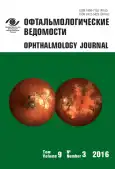Полиморфный маркер G1639A гена VKORC1 и развитие окклюзии сосудов сетчатки
- Авторы: Мошетова Л.К.1, Кахкцян Ш.С.1, Сычев Д.А.1, Туркина К.И.1, Гришина Е.А.1, Рыжикова К.А.1, Созаева Ж.А.1
-
Учреждения:
- ФГБОУ ДПО Российской медицинской академии последипломного образования Минздрава России
- Выпуск: Том 9, № 3 (2016)
- Страницы: 5-9
- Раздел: Статьи
- URL: https://journals.rcsi.science/ov/article/view/5346
- DOI: https://doi.org/10.17816/OV935-9
- ID: 5346
Цитировать
Аннотация
Актуальность. Окклюзия сосудов сетчатки (ОСС) является заболеванием глаза, которое приводит к снижению зрения, вплоть до слепоты. ОСС наблюдается от 1 до 2 % лиц старше 40 лет. Этиология ОСС до сих пор является неясной. Однако наиболее признанными факторами риска являются возраст, артериальная гипертензия, гиперлипидемия, атеросклероз, сердечно-сосудистые заболевания, сахарный диабет. В последние годы возросло число пациентов с ОСС среди молодого населения, в связи с чем большее внимание уделяют генетическому фактору. Одним из факторов, приводящих к окклюзиям сосудов сетчатки, является полиморфизм генов, кодирующих цикл витамина К. По данным литературы, полиморфизм 1639G4A гена витамин К эпоксидредуктазы субъединицы 1 (VKORC1) — возможный новый фактор риска для ОСС.
Цель исследования: оценка ассоциации носительства генотипов по полиморфному маркеру G1639A гена VKORC1 с развитием венозных и артериальных окклюзий сосудов сетчатки.
Материалы и методы. В исследование были включены 126 пациентов в возрасте от 40 до 80 лет, средний возраст 61,5 года. Генотипирование по полиморфному маркеру G1639A гена VKORC1 проводилось методом ПЦР. Статистическая обработка осуществлялась при помощи программы Instat.
Результаты. Генотип GG встречался статистически значимо чаще у пациентов с венозной ОСС по сравнению с лицами без патологии сосудов сетчатки (42,6 vs 32 %, р = 0,0449). Обнаружена тенденция к большей частоте генотипа GG у пациентов с АОСС по сравнению с лицами без патологии сосудов сетчатки (60 vs 32 %, р = 0,0925). Однако генотип АА по полиморфному маркеру G1639A гена VKORC1 статистически значимо реже встречался у пациентов с венозными ОСС по сравнению с лицами без сосудистой патологии сетчатки (9,8 vs 28 %, р = 0,0238, RR 2,015, ID 95 % 1,011–4,16). Обнаружена тенденция к более низкой частоте генотипа АА у пациентов с артериальными ОСС по сравнению с группой контроля (6,7 vs 28 %, р = 0,1593). Заключение. Генотипирование полиморфизма G1639A гена VKORC1 в группах пациентов с венозной и артериальной ретинальной окклюзией, а также у здоровых лиц показало, что носительство мутантного А-аллеля (генотипы GA и AA) одинаково часто встречается во всех трёх группах. При этом генотип АА достоверно реже встречается у лиц, с острыми сосудистыми заболеваниями сетчатки, особенно при артериальной эмболии. Так как генотип 1639АА гена VKORC1 ассоциирован с гипокоагуляционным сдвигом плазменного гемостаза, можно предположить, что наличие данной мутации снижает риск развития окклюзий ретинальных сосудов.
Ключевые слова
Полный текст
Открыть статью на сайте журналаОб авторах
Лариса Константиновна Мошетова
ФГБОУ ДПО Российской медицинской академии последипломного образования Минздрава России
Автор, ответственный за переписку.
Email: moshetovalk@yandex.ru
д-р мед. наук, академик РАН, профессор Россия
Шушаник Сейрановна Кахкцян
ФГБОУ ДПО Российской медицинской академии последипломного образования Минздрава России
Email: k.shushan@mail.ru
аспирант кафедры офтальмологии Россия
Дмитрий Алексеевич Сычев
ФГБОУ ДПО Российской медицинской академии последипломного образования Минздрава России
Email: dimasychev@mail.ru
д-р мед. наук, профессор Россия
Ксения Ивановна Туркина
ФГБОУ ДПО Российской медицинской академии последипломного образования Минздрава России
Email: kseniyait@mail.ru
канд. мед. наук, доцент Россия
Елена Анатольевна Гришина
ФГБОУ ДПО Российской медицинской академии последипломного образования Минздрава России
Email: gelana2010@yandex.ru
канд. мед. наук, зам. руководителя НИЦ, зав. отделом молекулярно-биологических исследований Россия
Кристина Анатольевна Рыжикова
ФГБОУ ДПО Российской медицинской академии последипломного образования Минздрава России
Email: kriistinkaa@mail.ru
младший научный сотрудник отдела молекулярно-биологических исследований НИЦ Россия
Жаннет Алимовна Созаева
ФГБОУ ДПО Российской медицинской академии последипломного образования Минздрава России
Email: sozaeva@yandex.ru
лаборант-исследователь отдела молекулярно-биологических исследований НИЦ Россия
Список литературы
- Flammer J, Konieczka K, Bruno R, et al. The eye and the heart. J Eur Heart. 2013;34(17):1270-1278. doi: 10.1093/eurheartj/eht023.
- Lee J, Yoon Y, Kim H, et al. Baseline characteristics and risk factors of retinal vein occlusion. J of Korean Medical Science. 2013;28(1):136-144. doi: 10.3346/jkms.2013.28.1.136.
- Lecumberri J, Balbas C, Villanueva J, Hernandez J. Thrombophilia and vascular risk factors in retinal vein occlusion. J Revistaclinica Espanola. 2013;213(5):229-234. doi: 10.1016/j.rce.2013.01.012.
- Risse F, Frank R, Weinberger A. Thrombophilia in patients with retinal vein occlusion: a retrospective analysis. J Ophthalmologica. 2014;232(1):46-52. doi: 10.1159/000360013.
- Glueck C, Hutchins R, Jurantee J, et al. Thrombophilia and retinal vascular occlusion. J Clinical Ophthalmol. 2012;6:1377-1384. doi: 10.2147/OPTH.S34627.
- Aggarwal R, Mirshra V, Aggarwal S. Oral contraceptive pills: A risk factor for retinal vascular occlusion in in-vitro fertilization patients. J of Human Reproductive Sciences. 2013;6(1):79-81. doi: 10.4103/0974-1208.112389.
- Oldenburg J, Marinova M, Muller-Reible C, Watzka M.
- The vitamin K cycle. J Vitamins and Hormones. 2008;78:36-54. doi: 10.1016/S0083-6729(07)00003-9;2008.
- Oldenburg J, Bevans C, Muller C, Watzka M. Vitamin K epoxide reductase complex subunit 1 of the vitamin K cycle. J Antioxidants and Redox Signaling. 2006;8(3):347-351. doi/abs/10.1089/ars.2006.8.347.
- Тульцева С.Н., Астахов Ю.С. Окклюзии вен сетчатки. — СПб.: Н-Л, 2010. – С. 7–39. [Tul’tseva SN, AstakhovYS. Retinal vein occlusion. Saint Petersburg: N-L; 2010;7-39 (In Russ).]
- Тульцева С.Н. Тромбофилия как фактор риска развития тромбозов центральной вены сетчатки у лиц молодого возраста // Офтальмологические ведомости. – 2008. – Т. 1. – № 1. – С. 46-51. [Tul’tseva SN. Thrombophilia as a risk factor for the thrombosis development of the central retinal vein in young adults. Ophthalmology Journal. 2008;1(1):46-51. (In Russ).]
- Bodin L, Horellou M, Flaujac C, et al. A vitamin K epoxide reductase complex subunit-1 (VKORC1) mutation in a patient with vitamin K antagonist resistance. J Thrombosis and Haemostasis. 2005;3:1533-5. doi/10.1111/j.1538-7836.2005.01449.
- Weger M, Stein-Brugger I, Wilfried R, et al. Role of the vitamin K epoxide reductase complex subunit I (VKORC1) — 1639G >A gene polymorphism in patients with retinal vein occlusion. J Current Eye Research. 2013;38(12):1278-1282. doi: 10.3109/02713683.2013.
- Ortak H, Sogut E, Demir H, et al. Preductive value of the vitamin K epoxide reductase complex subunit 1 G-1639A and C1173T single nucleotide polymorphisms in retinal vein occlusion. J Clinical and Experimental Ophthalmology. 2012;1-6. doi:10.1111 /j.1442-9071.2012.02780.
Дополнительные файлы







